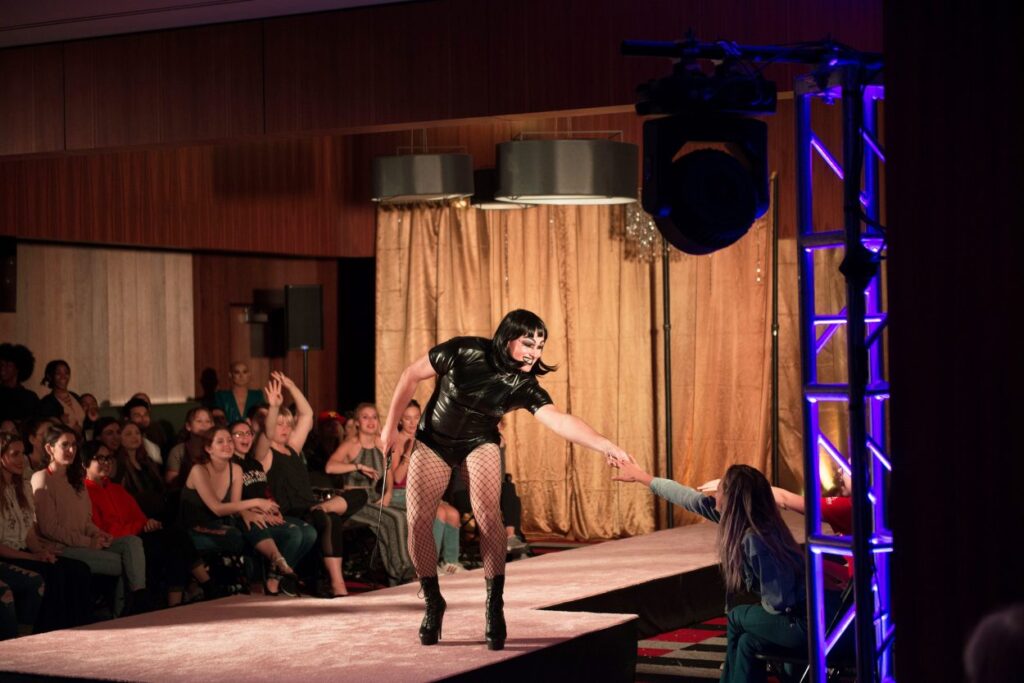
Written by Mitali Shukla
As a young child in the Philippines, 37-year-old Ryan Paolo – known by his drag queen name Ongina – discovered his passion for drag. On April 12, Paolo, a season one contestant of popular TV show “RuPaul’s Drag Race,” performed on the Student Union Stage in Argyros Forum at the seventh annual Chapman Drag Show – along with previous “RuPaul’s Drag Race” contestants Mariah Balenciaga, Kimora Blac, and Laganja Estranja.
“I love the energy (the audience) gives me, which inspires me every time I’m on stage,” Jay Jackson – also known as Laganja Estranja – told The Panther. “It doesn’t matter if I’m performing to a crowd of 20 or to a crowd of thousands – 99 percent of the time, they’re there to see a drag show and they love it.”
Four student performers also took the stage, beginning with Rosa Sharks, then Queen Jade, Correction: An earlier version of this story misspelled the stage name of Goldeene Jazzflats and Pal Poxy. The queens performed intricate and provocative dance routines with detailed, colorful costumes, lip syncing to popular songs in the LGBTQIA+ community like “Judas,” by Lady Gaga. The audience of around 100 people responded with clapping, hollering and rounds of applause. Some of the student queens were returning performers and some were performing drag for the first time.
“Historically, drag queens have led the way when it comes to gay rights, so we have a lot to thank drag for today,” said attendee and junior sociology major Andreas Ter-Borch. “Multiple genders are represented and in that sense, it’s very inclusive. There isn’t really a wrong way to do drag.”
The four drag queens from various seasons of “RuPaul’s Drag Race” executed dance numbers with an array of different costume and wig changes. The “death drop,” which is a type of dance in which a dancer falls to the ground in a pose, is one of the most exciting renditions of the splits, Ter-Borch said.
“I love the unexpectedness of it all. You never know what a queen is going to look like coming out or what she’s going to lip sync to,” Ter-Borch said.
“There’s nothing more jaw-dropping than a death drop.”
In between performances, the queens thanked those who organized the event and fellow members of the LGBTQIA+ community.
“It’s L-G-B-T-Q-A-plus, got that? But you don’t need a label,” Jackson told the audience.
Following the performances, there was a Q&A portion of the show where the four “RuPaul’s Drag Race” queens answered questions from the audience. One of the audience members asked them how they felt about RuPaul, the host of the drag show competition.
“I’m a very emotional person. I was really hurt when I was eliminated and RuPaul didn’t hug me,” Jackson said. “I told him this while I was on his podcast and ever since then, each time I see him, he’s hugged me. Underneath it all, he’s a good man.”
Mariah Balenciaga, whose real name is Elijah Kelly, went on to say that RuPaul had to endure the difficulties of doing drag at a time where it was not as culturally and socially accepted. He encouraged the audience to learn about the history of drag and what their predecessors had to go through to get where they are today.
“Drag is more than just men dressing up as women,” Kelly said. “It’s an art and a form of self-expression.”
When Paolo was asked if he ever feels uncomfortable in his line of work, he said there are certain aspects that make him feel unsafe.
“With the shootings at gay bars and nightclubs, it’s impossible not to think about my safety. I can’t be afraid, because then it would mean that I let the hate win,” Paolo told the Panther. “As far as being uncomfortable – I don’t anymore. I figure, if you don’t like me or my drag, then that’s on you. Not me.”

